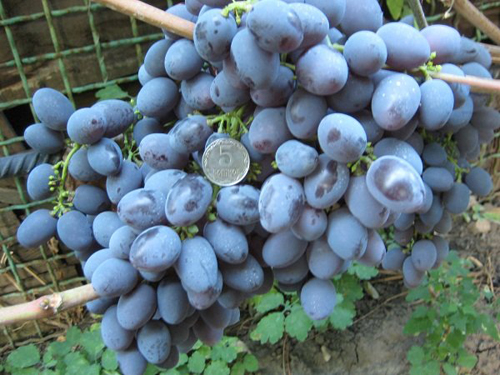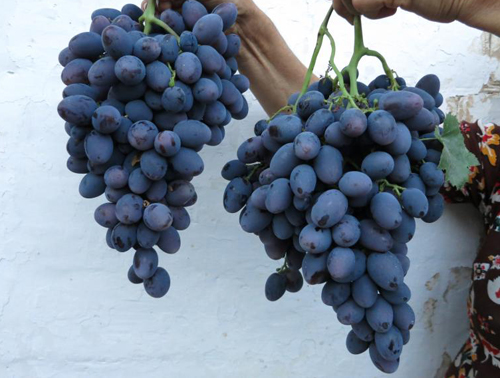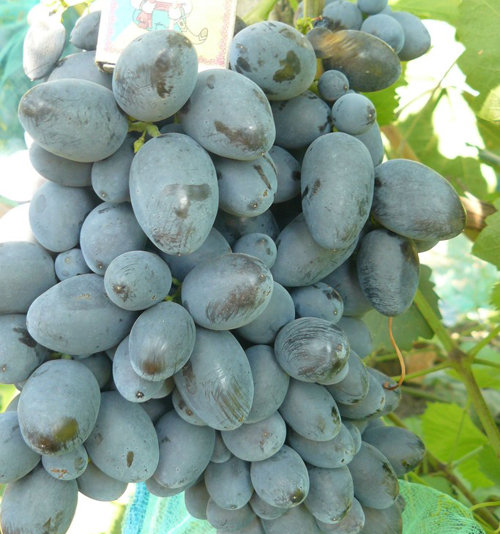Gala grape variety
The hybrid form of table dark-colored Gala grapes is the fruit of the work of a talented folk breeder from Zaporozhye Vitaly Zagorulko. In recent decades, many wonderful new varieties of the "sun berry" have been bred by his hands, which have received well-deserved recognition, and our heroine takes a worthy place among them.

It was obtained by crossing two famous varieties - Gift to Zaporizhzhia, originally from Ukraine, and Codryanki, selection of the Moldavian Research Institute of Viticulture and Winemaking. Each of them in itself possesses outstanding qualities, many of which were passed on to their offspring. As a result of the hybridization, very vigorous plants were obtained, demonstrating a high and stable yield of early maturing bunches of excellent appearance and taste. In addition, the hybrid has an increased resistance to disease, but its resistance to frost is average. And, nevertheless, by the totality of all factors, Gala is highly valued by many winegrowers, gradually expanding the geography of its distribution.
Agrobiological characteristics
The grape bushes are very vigorous. The crown of the young shoot is greenish-gray due to abundant pubescence, the axis of the shoot has pinkish tones, the young leaves are wrinkled and shiny. The formed leaves are dark green, rounded or somewhat stretched in width, wavy, five-lobed, practically without dissection. The leaf surface of the variety is finely bubbly. The lateral notches are either absent altogether, or may be barely outlined. Petiole notches are mostly open lyre-shaped with a sharp bottom, but vaulted ones can also be found. Petioles are comparable in length to the main vein of a leaf, greenish-pink in color. The denticles at the edges of the leaf blade are of medium size, triangular and saw-shaped with a wide base, convex edges and pointed apices. The flowers are bisexual, which allows the inflorescences to perfectly pollinate with their own pollen and form large berries without signs of peas. Green shoots, despite their very high growth, ripen well, not less than 2/3 of their length, and in favorable climatic conditions - completely. Ripe grape shoots acquire a matte brown color.
The bunches of Gala are very elegant and large, up to 25 cm long and more, up to 18-20 cm wide. Their average weight is 600-900 grams, the most massive - up to 2 kg. The shape is broadly conical, the density is medium, the uniformity of the berries is excellent. The grapes in the brush are not deformed or damaged against each other. The combs in the variety are long and strong, their color is similar to the color of leaf petioles. The berries are large, oval, dark blue with a thick gray prune bloom, weighing 10-12 grams. The pulp is dense, juicy and fleshy, with a refreshing sweet and sour taste, but without a bright varietal aroma. Sugar accumulation at the beginning of the phase of removable maturity is average - 15.5-16.5 g / 100 ml of juice, titratable acidity 7-8 g / l. With the onset of full ripeness, the sugar content slightly increases, and the acid content decreases. The skin of the berries is quite dense, but at the same time, eaten. The seeds are available in the amount of 2-3 pieces. The tasting qualities of the berries are rated as high, although some gourmets lack sweetness.

The crop is used for fresh consumption. The high presentation of the grapes determines its excellent demand on the market, and the early ripening period ensures the possibility of its sale at relatively high prices. Thanks to this, the hybrid enjoys interest from farmers who grow it for sale.The variety also occupies a worthy place among amateurs in their private plots, because in addition to direct use for food, Gala is successfully used for home canning, during which delicious and richly colored compotes, preserves and jams are prepared from it. The transportability of the bunches is good, which allows them to be transported over long distances without much damage. They are capable of being stored for an average period of time, provided that an optimal microclimate for this purpose is created.
Harvest ripens in the south in the first decade of August. The growing season from the time the buds open until the grapes are ready for harvest is 110-115 days, characterizing the hybrid as early maturing. During this time, he needs a relatively small amount of heat, amounting to 2250-2350 ° C. These indicators make it possible to expand the geography of the distribution of this variety far beyond the traditional wine-growing regions, up to the southern regions of the Non-Black Earth Region of the European part of our country. Theoretically, there is a possibility of its ripening a little further north, however, in the coldest seasons, Gala berries, which are already not the most outstanding in terms of sugar accumulation, may turn out to be slightly edible there. Do not forget about the very moderate indicators of frost resistance of the form (-20 ... -21 ° C), because of which, even in the south, it needs a reliable shelter for the winter.
Yield indicators are one of the main reasons for pride in this variety. Up to 20 kilograms of grapes from a bush, powerful, well-developed plants "stretch" without any signs of congestion. A high percentage of fruiting shoots and a significant number of inflorescences on them allows laying a much larger potential yield, but this should not be allowed, since the payment for the immoderate generosity of the variety can be a decrease in the taste of berries, an extension of the growing season, and most importantly, the weakening of plants that may even die after several seasons of regular overload. To prevent these negative phenomena, the bushes must be strictly normalized with shoots and yield, as well as the obligatory correlation of these indicators with the age of the plant, the strength of its growth and vital energy. This should be done especially carefully in regions with not the highest rates of heat supply, where any delay in the growing season is very critical.

After the onset of removable ripeness, if the weather permits, you can leave the grapes on the bushes to achieve more harmonious ratios of sugar and acid. It should be borne in mind that this variety has a certain predisposition to cracking berries in the event of a sharp change in soil moisture, which often happens when heavy rains come to replace a prolonged drought. As a result, the crop can largely lose its presentation, up to complete unsuitability for sale. Overripe sweet berries can also attack wasps, although at the first stages of ripening they are not particularly interested in Gala. These circumstances force the grower to think, weighing all the pros and cons with regard to the justification of such a risk in order to improve the taste of the bunches in the process of full maturation.
Agrotechnical features
The economic characteristics of grapes can be assessed as quite good. In relation to our heroine, one cannot complain about excessive effeminacy or the need for any specific care for her. The main activities in the vineyard correspond to the traditional cultivation technique for the culture, and only a few features distinguish it from other medium-resistant varieties.
Planting should be carried out in areas suitable for viticulture.The hybrid form grows equally vigorously both on the plains and on the slopes, while the main factor is the supply of heat to the plants. In the south, where the indicators of the sum of active temperatures more than cover its needs, this requirement may not be so relevant, but in the northern regions, where amateurs often pay attention to Gala due to its early ripeness, it is necessary to take care in advance of creating a microclimate favorable for grape bushes ... To do this, they are placed in a wall culture on the south side of houses, outbuildings, dense fences and hedges, where they will be protected from cold winds. In the case of laying large-scale farm plantings, you should choose a site in the upper part of the slopes of warm exposures.
Due to the lack of data on resistance to root phylloxera, planting of our heroine in regions infected with this pest is possible only with grafted seedlings, while in places that are guaranteed free from root aphids, its propagation by easily rooting cuttings is widely practiced. Depending on the method chosen, the timing of the entry of the variety into fruiting may also differ. Own-rooted plantings are transferred to it, as a rule, a year earlier than the grafted ones. The feeding area for vines with significant vigor should be adequate. Our heroine, in particular, requires 4.5-5.5 sq. meters of land.
Almost everywhere where Gala is grown, she needs to cover the aboveground part for the winter. Its method and thickness will differ depending on the frost hazard of the local climate. If in the south it is enough to bury the vine in the ground, then in regions with harsh winters it will be necessary to insulate it with straw, wood shavings, spruce branches, a needle holder or other organic material, followed by protection of the entire structure from thawed moisture using wooden shields, film or roofing material. Good results are also shown by light film shelters, like mini-greenhouses, the temperature under which in winter is 7-8 degrees higher than in the open air.
The load of the bushes of this variety during pruning is on average 30-40 eyes, taking into account the average shortening of fruit arrows of grapes to 6-8 buds. When a fragment is removed, weak and sterile shoots are removed, and before flowering, only one strong bunch is left on each of the remaining ones.
The resistance of the hybrid to fungal pathogens is above average. Resistance to mildew and powdery mildew is 3-3.5 points, and therefore, to combat them, several prophylactic fungicidal treatments are required during periods of the highest harmfulness - before and after flowering grapes. During the subsequent growing season, it is necessary to constantly monitor the bushes, and take point, but effective measures when foci of damage by pathogens appear. Some growers complain that Gala is susceptible to gray rot, for the prevention of which it is possible to recommend agrotechnical measures. In particular, early clarification of the fruit zone of plants will be very useful. Thanks to this technique, the bunches will be better ventilated, which will reduce the likelihood of developing diseases on them by an order of magnitude, and at the same time will improve their insolation, which will also increase the quality of the crop.








